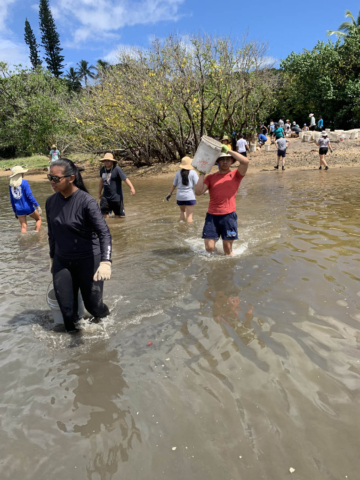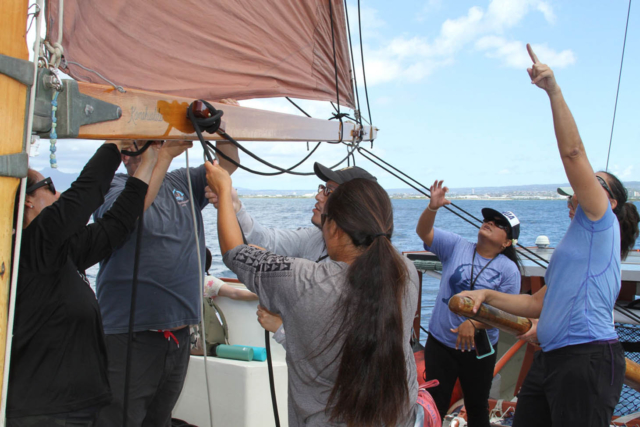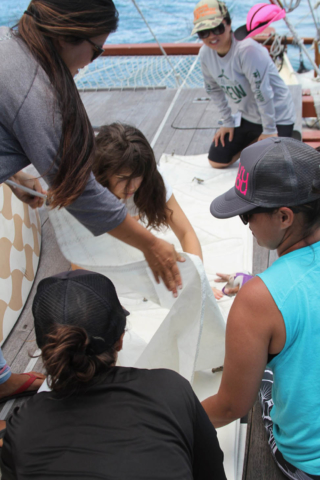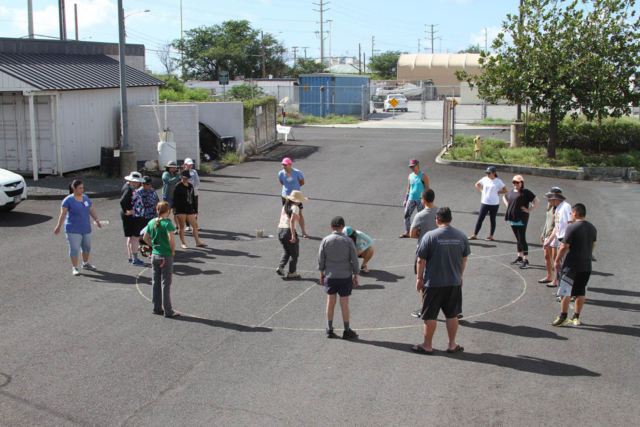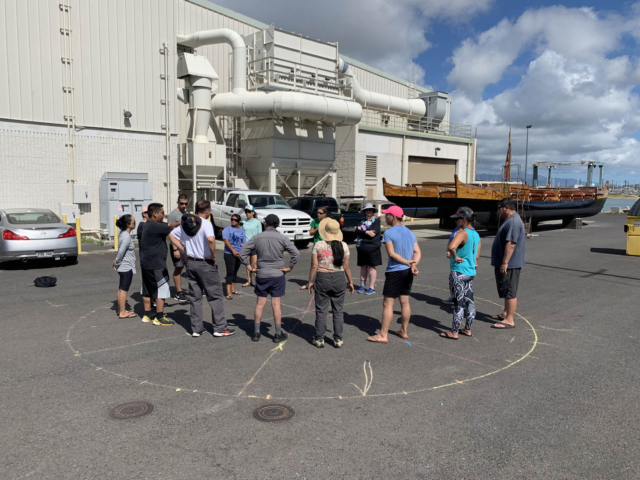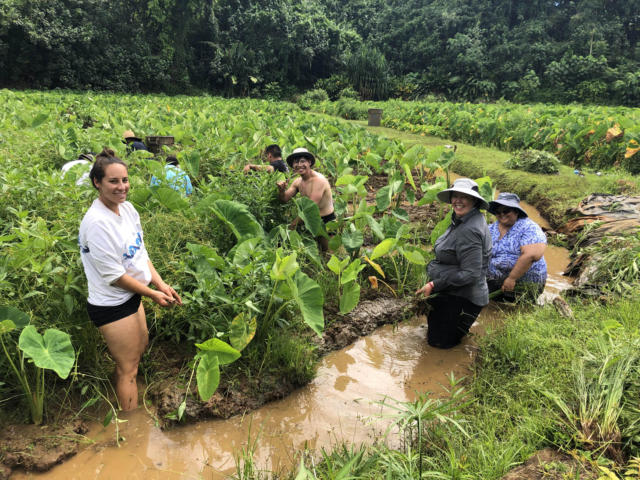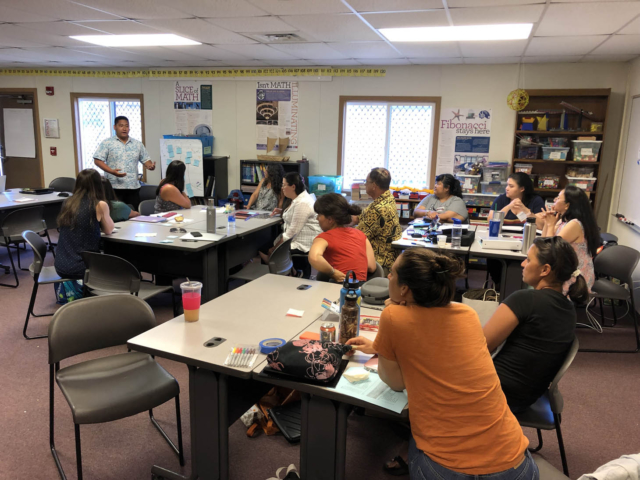
All Aboard the Mālama Honua Worldwide Voyage
- Posted on 29 Jul 2019
- In Education, Environment, Newsletter, Science, Teachers
The following post comes from our friend Margaret Miura, Ethnomathematics Graduate Certificate, Cohort #12
In July 2019, educators from Kahnawake, Canada; Juneau, Alaska; Tallahassee, Florida; Magnolia, Texas; San Diego and Los Angeles, California; and across the Hawaiian Islands gathered for the start of the 12th cohort of the annual ethnomathematics program at the University of Hawai‘i at Mānoa College of Education.
We began our voyage as strangers hailing from as far as 4,500 miles away and as close as my neighborhood of Pālolo Valley on O‘ahu. We spent a week immersed in the lo‘i kalo (taro patch) of Ho‘okua‘āina at Kapalai Farms, loko i‘a (fish pond) at Paepae o He‘eia, and learning the basics of sailing and wayfinding with the Polynesian Voyaging Society (PVS).

Photos taken by Antonina Monkoski-Takamure
We ended our first week together on Hawai‘i Island (Maunakea, Keauhou Bird Conservation Center, and Hawai‘i Volcanoes National Park) connecting with one another by giving back and caring for the ‘āina (land) through service projects and hands-on learning. Ethnomathematics seeks “to understand mathematical knowing/doing…in the contexts of different interest groups, communities, peoples and nations” (D’Ambrosio, 2001, p. 8).
To me, ethnomathematics is solving everyday problems in your own language with the tools and knowledge handed down from generation to generation.

Photos taken by Antonina Monkoski-Takamure
I chose this ethnomathematics program journey to better reach and teach students, yet found I am a part of something even bigger. In an article, Nainoa Thompson described how the overwhelming excitement of greeters literally sank the stern of Hōkūle‘a upon her maiden voyage to Tahiti. Like Hōkūle‘a, the classroom may be limited to how many students we can hold at a time, but the deck of Mālama Honua (“to care for our Earth”) movement is broad enough to hold the voyages of the world.

Hōkūleʻa’s arrival to Tahiti in 1976
As educators, we begin our voyage in the classroom to launch students into the world. Our job is to provide a vessel students are clamoring to get on board because their eyes have been opened to the possibilities to connect to the world and make a difference. The ‘ike (knowledge) gained by the PVS set in motion, Mālama Honua, the metaphorical canoe big enough to hold anyone and everyone. We experienced this first-hand during our sail with PVS crew.

Photos taken by Antonina Monkoski-Takamure
Joe Manfre, Hawaiʻi Department of Education (HIDOE) State Math Specialist, joined us on the sail and reflected, “I was already a believer in ethnomath. The ‘why’ was easy to buy into. Now, I understand how it can be put to use from the experience you provided. As we move to create more relevant learning experiences for our students, it’s obvious that this should play an integral part of what we offer them. Purposeful, authentic, place-based learning.”
Students, when provided lessons that build on their identity, culture, and history, become part of that legacy, ensure the knowledge is not lost, and shape the future. This ties directly into the HIDOE vision for our students to one day “contribute positively to our community and global society.” As educators, we seek to help students make connections with cultural practices and educational standards. Mahalo to all who came before and brought us to this point and to those who will continue the journey.
E kaupē aku nō i ka hoe a kō mai.
Put forward the paddle and draw it back. Go on with the task that is started and finish it (Pukui, 1983, #319).
Photos taken by Antonina Monkoski-Takamure
References
D’Ambrosio, U. (2001). Ethnomathematics. Rotterdam, Netherlands: Sense Publishers.
Hawaii Forest Institute. (2009-2016). Keauhou Bird Conservation Center Discovery Forest. Retrieved July 13, 2019 from https://www.hawaiiforestinstitute.org/
Hawaii State Department of Education. (n.d.) Student Learning. Retrieved July 13, 2019 from http://www.hawaiipublicschools.org/TeachingAndLearning/StudentLearning/Pages/home.aspx
Ho‘okua‘āina. (n.d.). Ho‘okua‘āina Rebuilding Lives from the Ground Up. Retrieved July 13, 2019, from https://www.hookuaaina.org
National Park Service. (October 25, 2018). Hawai‘i Volcanoes National Park. Retrieved July 13, 2019 from https://www.nps.gov/havo/planyourvisit/basicinfo.htm
Office of Maunakea Management. (2004-2019). OMKM. Retrieved July 13, 2019 from http://www.malamamaunakea.org/
Paepae o He‘eia. (2013) He‘eia Fishpond, He‘eia O‘ahu. Retrieved July 13, 2019 from https://paepaeoheeia.org/
Pukui, M. K. (1983). ‘Ōlelo No‘eau. Honolulu, Hawaii: Bishop Museum Press.
Thompson, N. (n.d.). Voyaging and the Revival of Culture and Heritage [Web log post]. Retrieved July 13, 2019, from http://archive.hokulea.com/ike/intro_ike.html


